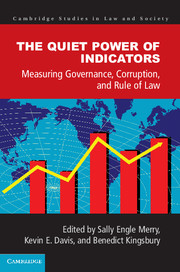Book contents
- Frontmatter
- Contents
- Notes on Contributors
- Acknowledgments
- Introduction: The Local-Global Life of Indicators: Law, Power, and Resistance
- PART I GLOBAL INDICATORS OF GOVERNANCE, CORRUPTION, AND RULE OF LAW
- 1 International Organizations and the Production of Indicators: The Case of Freedom House
- 2 Indicators and the Law: A Case Study of the Rule of Law Index
- 3 Measuring Corporate Accountability through Global Indicators
- 4 The Quest for Measuring Development: The Role of the Indicator Bank
- 5 Tradeoffs in Accountability: Conditionality Processes in the European Union and Millennium Challenge Corporation
- Part II INDICATORS IN LOCAL CONTEXTS
- Index
- Books in the Series
- References
2 - Indicators and the Law: A Case Study of the Rule of Law Index
from PART I - GLOBAL INDICATORS OF GOVERNANCE, CORRUPTION, AND RULE OF LAW
Published online by Cambridge University Press: 05 June 2015
- Frontmatter
- Contents
- Notes on Contributors
- Acknowledgments
- Introduction: The Local-Global Life of Indicators: Law, Power, and Resistance
- PART I GLOBAL INDICATORS OF GOVERNANCE, CORRUPTION, AND RULE OF LAW
- 1 International Organizations and the Production of Indicators: The Case of Freedom House
- 2 Indicators and the Law: A Case Study of the Rule of Law Index
- 3 Measuring Corporate Accountability through Global Indicators
- 4 The Quest for Measuring Development: The Role of the Indicator Bank
- 5 Tradeoffs in Accountability: Conditionality Processes in the European Union and Millennium Challenge Corporation
- Part II INDICATORS IN LOCAL CONTEXTS
- Index
- Books in the Series
- References
Summary
INTRODUCTION
This chapter explores some of the ways in which indicators interact with law. Accordingly, it studies the Rule of Law Index, an indicator developed and applied by the World Justice Project to measure the adherence of almost 200 countries to the rule of law. Such quantitative technologies of measurement, this chapter argues, are here to stay in the law and development agenda. They create a community of practice and provide normative criteria for the evaluation of whether a country adheres to their particular idea of what the rule of law is (and is not). Because of their origin in multilateral financial institutions, the Index and other rule of law indicators tend to be seen by some as implausible neoliberal simplifications that simply should be dismissed. This chapter takes a different perspective. Irrespective of the Index's origins, the genie is out of the bottle. Rule of law indicators are veritable technologies of global governance, and it is therefore important to engage with them, as they open a space for contestation, intervention, and policy debate on what it means to encourage the rule of law in the developing world.
The chapter is organized in three parts. The first one puts the Index in context and argues that it can be read as an expression of a post-neoliberal moment of the law and development agenda. The second part unpacks the Index itself– its added-value and methodology– and proposes a characterization of the notion of rule of law that underlies it. According to this section, the “rule of law” of the Index is substantive, non instrumental, and features a certain realist sensibility. Building on these premises, in the third part I rethink the role that the Index, and other rule of law indicators like it, play in global governance. The fourth part concludes the chapter.
- Type
- Chapter
- Information
- The Quiet Power of IndicatorsMeasuring Governance, Corruption, and Rule of Law, pp. 75 - 102Publisher: Cambridge University PressPrint publication year: 2015
References
- 18
- Cited by



